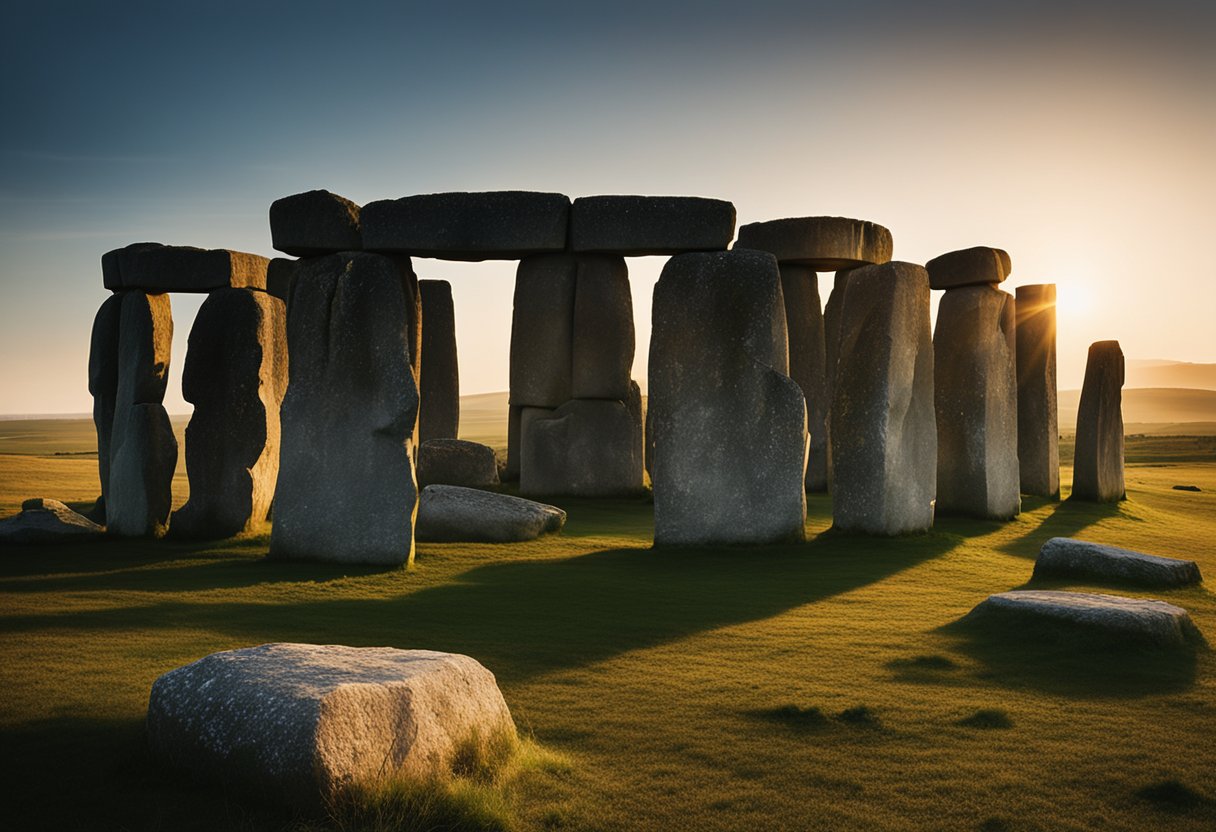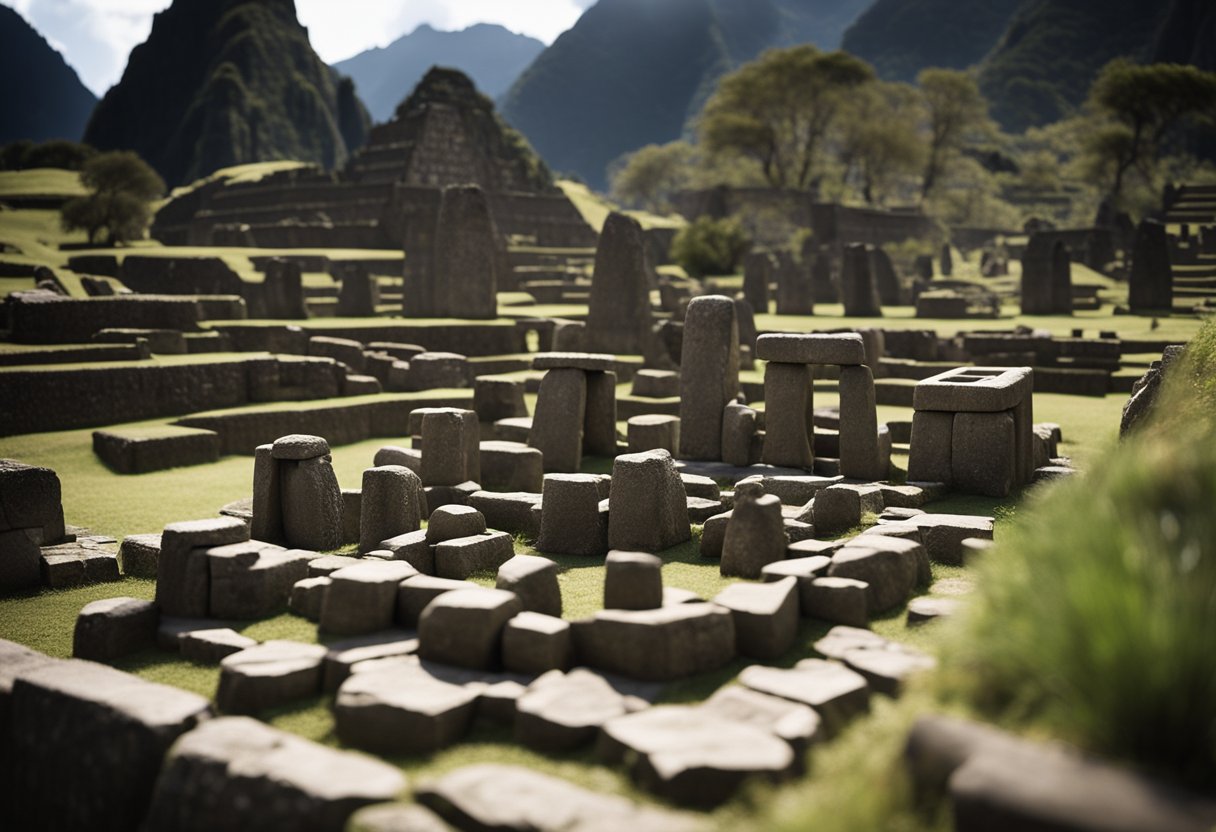Ancient Astronomy: Exploring Celestial Insights from Stonehenge to Machu Picchu!

Updated On: April 23, 2024 by Esraa Mahmoud
Ancient astronomy has been a cornerstone of civilisation for thousands of years, influencing cultures across the globe. From the enigmatic stone circles of Stonehenge in the United Kingdom to the meticulously aligned structures of Machu Picchu in Peru, our ancestors developed sophisticated ways to track celestial movements and integrate this knowledge into their daily lives. Their achievements in observing and understanding the cosmos highlight the importance of astronomy in history and its impact on science and society.

As we explore these ancient sites, we uncover the ingenious methods used by different cultures to observe the heavens. This deep connection between the sky and our forebears goes beyond practical applications like agriculture and navigation; it enters the realm of the spiritual, where celestial events are woven into the very fabric of myths and religions. The interconnectedness of astronomy with ancient engineering and construction further unveils the remarkable capabilities of early astronomers and builders.
The Significance of Stonehenge
Stonehenge remains an iconic symbol of Britain’s Neolithic past, reflecting remarkable architectural ambition and a sophisticated understanding of celestial events. It is key in exploring ancient civilisations and their relationship with the skies.
Architectural Marvel
Stonehenge is a testament to the ingenuity of its builders. Erected in the UK during the Neolithic period, it is the most architecturally sophisticated prehistoric stone circle in the world, and quite uniquely, it features lintelled stones. These massive sarsen stones form trilithons that stand in a horseshoe arrangement. Incredibly, the builders transported these stones from up to 200 miles away, a colossal feat in the era before the wheel was used in the local area.
Astronomical Purpose
It’s widely accepted that Stonehenge served as a calendar, marking the passage of the Sun and Moon and their relationship with the seasons. The alignment of the stones with the Summer Solstice sunrise and the Winter Solstice sunset has long intrigued archaeologists. In addition, the monument’s orientation on the sunrise of the Summer Solstice and the opposing sunset during the Winter Solstice provides compelling evidence of its use for observing astronomical events. Stonehenge may have allowed Neolithic people to predict phenomena such as eclipses, which were significant both scientifically and for their ritual implications.
This ancient monument’s scale and the precise alignment of its stones suggest an advanced understanding of mathematics and astronomy by the people who constructed it. The shadows cast by the stones could have served to mark the changing of the seasons, both Equinoxes and Solstices, forming a continuous link between their terrestrial world and the celestial realm overhead.
Astronomy of the Inca Empire
Astronomy was pivotal in the Inca Empire, serving practical and ceremonial functions. The Incas carefully observed celestial events and used their understanding to organise their calendar and agriculture.
Cusco and the Sacred Valley
In Cusco, formerly the capital of the Inca Empire, and the surrounding Sacred Valley, astronomical observatories were established to monitor the movements of the Sun. Structures like the Qorikancha, which means ‘Golden Enclosure’, served as a key site for solar observation. During the solstices and equinoxes, the Incas held ceremonies that coincided with the Sun’s alignment with certain architectural features, reflecting the importance of these cyclical celestial events to their agricultural calendar.
Machu Picchu’s Astronomical Alignment
At Machu Picchu, the famous Inca citadel perched high in the Andes, the Intihuatana stone aligns with the Sun during the winter solstice and when it stands directly overhead at Zenith Sun. The precise placement of this sacred stone and other terraces and structures at the site demonstrates the Inca’s advanced knowledge of astronomy. Overlooking the Urubamba River, Machu Picchu’s layout seems to be in harmony with its natural surroundings, and the Inca utilised this astronomical alignment to enhance their agricultural practices.
Celestial Observations in the Americas
As we explore the rich tapestry of celestial observations in the Americas, we find that ancient societies such as the Maya and the inhabitants of Chaco Canyon possessed profound knowledge of astronomical events. These cultures built sophisticated structures with a precision that reflected their deep understanding of the cosmos.
Mayan Skywatchers
The Maya civilisation, centred in what is now Mexico and Central America, was home to skilled astronomers. They meticulously tracked the movements of the Sun and Moon, predicting eclipses with remarkable accuracy. Mayan astronomers used pyramids and other impressive structures, aligning them with celestial bodies to serve as observatories and sacred spaces for rituals tied to the cosmos. For instance, the famed pyramid of Kukulkan at Chichen Itza displays a serpent shadow during equinoxes, a stunning example of their astronomical ingenuity.
Chaco Canyon’s Star Ceilings
Similarly, the ancient Pueblo peoples of Chaco Canyon, located in present-day New Mexico, USA, left behind a legacy etched in stone. The ceilings of some Great Houses, such as Pueblo Bonito, bear witness to their astronomical knowledge, incorporating alignments that track solar and lunar cycles. These patterns underscore the importance of astronomy in ritual and daily life for the Chacoans. Their landscape use, with buildings and roads oriented to capture solar and lunar standstills, reveals their sophisticated grasp of the heavens’ complex motions.
Ancient Observatories Worldwide
Across the globe, ancient observatories stand as testaments to the ingenuity of early civilisations in their quest to understand the cosmos. Focused on tracking celestial events, these sites often align with astronomical phenomena like solstices, marking significant times of the year.
Gaocheng Observatory in China
Initially constructed in 1276 during the Yuan Dynasty, the Gaocheng Observatory embodies China’s storied history in astronomy. It’s known for its remarkable sundial, the Gnomon, which was used to determine the Heavenly Middle—the observatory’s latitude—and make calendrical calculations. The ingenuity of the Gaocheng Observatory particularly shines through during the solstices, with its structures designed to measure the length of the solar shadow cast.
Newgrange Monument in Ireland
Over in Ireland, the Newgrange Monument is a prehistoric wonder older than Stonehenge and the Egyptian pyramids. This massive stone and turf structure was built around 3200 BC and is most famous for its alignment with the Winter Solstice. As the shortest day of the year dawns, Newgrange’s main passage is dramatically illuminated by the sunrise, revealing the advanced understanding of astronomy possessed by the Neolithic people of Ireland.
Understanding Equinoxes and Solstices
Equinoxes and solstices are key astronomical events that have captivated human interest throughout history. They mark significant points in the Earth’s journey around the Sun, defining our seasons and contributing to our understanding of time and space.
June and December Solstices
The June Solstice, occurring around 20 June to 22nd, is often called the Summer Solstice in the northern hemisphere and denotes the year’s longest day. Conversely, the southern hemisphere experiences the shortest day, the Winter Solstice. Sunlight reaches its maximum extent in the northern hemisphere, signalling the start of summer, while winter takes hold in the south with the shortest day.
The December Solstice happens around 20 December to 23rd. It inverts the June situation: the northern hemisphere experiences its shortest day (Winter Solstice), while the southern hemisphere basks in the longest (Summer Solstice). This solstice marks the peak of summer for countries below the equator and the onset of winter for those above.
March and September Equinoxes
The March Equinox, occurring around 20 March to 22nd, is when the Sun shines directly on the equator, resulting in nearly equal day and night lengths across the planet. This equinox heralds the start of spring in the northern hemisphere, known as the Spring Equinox, and autumn in the southern hemisphere, giving rise to Fall Equinox.
Similarly, the September Equinox falls around 22 September to 24th. On this day, the Sun once more aligns with the equator, and both hemispheres experience almost identical day and night lengths. It ushers in the Fall Equinox in the northern hemisphere and the Spring Equinox in the southern, signifying transition and balance in Earth’s orbital dance.
Mythology and Astronomy
In ancient times, civilizations intertwined the study of stars with rich mythologies, often portraying celestials as gods or epic creatures in the night sky.
Mythical Interpretations of the Skies
We see throughout history that different cultures have looked up to the stars and woven intricate stories to explain the celestial phenomena they observed. For instance, in the archaeoastronomy of Stonehenge, the alignment of the stones captures the essence of the summer solstice, with the sun rising directly above the Heel Stone. While some theories suggest Stonehenge functioned as an astrological observatory, others propose it held a deeper, spiritual significance, resonating with the sun’s power and marking the transition of seasons. Read more about the connections between Stonehenge and ancient astronomy.
Legends of the Constellations
Legends of the constellations reflect how ancient people sought to make sense of the patterns they observed in the night sky. For instance, the Pleiades, often known as the Seven Sisters, which has been a part of the mythology in cultures worldwide. The Pleiades were associated with abundance by the Inca and closely observed to predict the agricultural year. Learn about Inca astronomy and cultural interpretation of the skies.
Many constellations hold tales that are still recounted to this day. In Greek mythology, numerous constellations represent legendary heroes and beasts, such as Draco, the dragon, a constellation that snakes its way across the northern sky. Each constellation carries its legend, weaving a tapestry of stories among the stars that reflect the beliefs and values of their respective cultures.
Archaeoastronomy’s Role in Preservation

As custodians of history, we must safeguard the astronomical wisdom encapsulated within ancient sites. Archaeoastronomy is crucial in preserving these historic treasures by unravelling the mysteries locked in stones, ruins, and monuments. It’s the confluence of science and archaeology where the enduring legacy of our ancestors’ knowledge of the cosmos is preserved for future generations.
Modern Techniques and Ancient Sites
Technological advancements have given us sophisticated tools to analyse and conserve astronomical heritage. At sites like Stonehenge, we use digital scanning and 3D modelling to understand the alignments and significance of these mysterious megaliths. Through non-invasive methods, we ensure that the rocks’ structural integrity and story remain untainted. These techniques offer a blueprint for conservation, allowing us to maintain the authenticity of monuments and keep the authorship of ancient architects intact.
Conserving Astronomical Heritage
The ruins of Machu Picchu stand as a testament to the astronomical genius of the Inca civilisation. By studying the orientation of the Temple of the Sun, we can align our preservation efforts with the original intent of these celestial observatories. Our work helps to highlight the importance of these ruins, not just as mere relics but as living monuments of knowledge. In this light, preserving the astronomical heritage intertwines with the very fabric of archaeology, protecting the science behind the structures and the cultural narratives they embody.
In essence, archaeoastronomy is not only about understanding our past; it is about preserving a rich scientific tradition for the future. It is an ongoing dialogue between the generations, connecting us with the sky-watchers of yore and reminding us of our place in the broader cosmos.
Exploration and Rediscovery

In our pursuit of understanding ancient astronomical sites, two significant moments mark our collective journey: the rediscovery of Machu Picchu by Hiram Bingham and the relentless search for other lost cities that echo our ancestors’ sophisticated knowledge of the stars.
Hiram Bingham and Machu Picchu
In 1911, Hiram Bingham introduced the City of the Incas to the modern world. This ‘Lost City‘, hidden atop the verdant Peruvian Andes and forgotten for centuries, was a monumental rediscovery. Machu Picchu seems to merge with the celestial canvas above, proving that the site was a sophisticated astronomical observatory. The site’s alignment reflects the Incas ‘ advanced understanding of astronomy, from positioning temples to align with solstices to constructing the Intihuatana stone that acted as a solar clock.
Seeking the Lost Cities
Our quest does not end with Machu Picchu. Across the globe, we seek further evidence of our ancestors’ quest to connect with the cosmos. The Inca Trail, followed by many explorers after Bingham, continues to reveal lesser-known sites enriched with their historical narratives. Each rediscovery along the trail adds to the puzzle of our past, affirming that there are still numerous lost cities out beyond our current grasp, waiting to unveil their astral secrets.
Scientific Contributions to Ancient Astronomy

In addressing the vast field of ancient astronomy, it is crucial to highlight scientific research and archaeoastronomy’s pivotal role in our understanding of historical celestial observations. Such investigations have significantly advanced our knowledge of ancient cultures and their relationships with the cosmos.
University Research and Findings
Universities around the world have conducted extensive research into ancient astronomical sites. For example, University of Warsaw scholars have been key players in deciphering the astronomical significance of ancient structures. Their systematic studies often uncover alignments and artefacts that shed light on how ancient civilisations observed celestial events. Likewise, the University of Maryland has made substantial contributions, particularly through the Center for Archaeoastronomy, which focuses on interdisciplinary approaches to understanding the astronomical practices of historical societies.
Notable Archaeoastronomers
Among the trailblazers in this field is David Dearborn, a researcher whose extensive work has provided deeper insights into sites like the Sun Temple and Torreón at Machu Picchu. Such locations are thought to have served ritualistic purposes aligned with celestial observations. Dearborn’s work has demonstrated the scientific understanding of ancient civilisations, revealing complex knowledge of solar and lunar cycles, solstices, and equinoxes observed through these structures.
Solar Observation and the Inca Civilization
In the Inca Empire, the observation of the sun was intricately woven into their culture and religion, highlighting their sophisticated astronomical understanding.
Sun Temples and Rituals
The Incas revered the sun, or Inti, and developed several ceremonial centres known as Sun Temples. The most significant of these was the Temple of the Sun in Cusco, the empire’s capital. This temple played a crucial role in religious ceremonies and as a place for solar observation. Adjacent to the Temple of the Sun, the Temple of the Condor was another vital site, with its walls and wings designed to align with certain solar and celestial events.
- Sun Temples: Centres for worship and astronomy
- Rituals: Closely linked with solar movements and seasons
Intimachay: A Specialized Solar Observatory
Intimachay, meaning ‘Cave of the Sun’, was a unique structure at Machu Picchu dedicated to solar observations. Designed with precise alignments, it was used to track the December solstice, crucial for agricultural and ceremonial purposes. The structure’s small windows and position allowed it to precisely define the solstices by casting a specific light pattern on the cave’s back wall.
- Solstice observation: Crucial for Inca calendar
- Astronomical precision: Demonstration of Inca engineering
Engineering and Construction of Ancient Sites

When we explore the marvels of ancient engineering and construction, we witness the ingenuity in aligning these structures with celestial events and the natural landscape.
Stone Masonry and Monument Building
In ancient times, building monumental sites like Stonehenge involved a sophisticated understanding of stone masonry. Enormous sarsen stones and smaller bluestones were transported over vast distances, which still raises questions about the methods used by prehistoric people. Some theories suggest using wooden rollers, sledges, and river rafts for transportation. For example, at Stonehenge, placing stones in specific geometric shapes also showcases an early form of architectural knowledge.
The technique of shaping and setting these heavy stones is a testament to their skill. Mortise-and-tenon joinery was utilised to fit stones securely together—a clear sign they mastered the balance between aesthetical design and functional stability.
Landscape and Astronomy
The alignment of ancient sites with astronomical bodies reveals the significance of landscape in their construction. The builders of these sites deeply understood the motions of the sun, moon, and stars and incorporated this into their engineering. For instance, monuments like Stonehenge and the Pyramids of Giza are precisely aligned with solstices and celestial events, serving dual purposes for ceremonial significance and astronomical observation.
The strategic positioning of these structures required careful planning and often involved using sightlines—clear visual paths that connect different landscape features—to observe celestial events. This integration of construction and celestial observation demonstrates how our ancestors used the natural environment to complement and enhance their architectural efforts.
These subsections have examined the extraordinary efforts to build monumental sites and their symbiotic relationship with astronomy and landscape.
Frequently Asked Questions
In this section, we explore the intricate connections between ancient structures and the cosmos, shedding light on the celestial alignments of Stonehenge, the astronomical purposes of Machu Picchu, and the significance of these sites to their builders.
What is the significance of the alignments at Stonehenge during the equinoxes?
Stonehenge is masterfully aligned with the sun’s movements, particularly during the equinoxes, when the sun rises perfectly with the Heel Stone. This precise orientation highlights the builder’s deep understanding of the solar cycle.
How did ancient civilisations use Machu Picchu in relation to celestial events?
Ancient civilisations, such as the Inca, ingeniously incorporated celestial events into the design of Machu Picchu. They created structures aligned with solar phenomena, using them as an astronomical observatory to track the sun’s path, which is vital for agriculture and ceremonial purposes.
Who were the builders of Stonehenge, and what was their astronomical knowledge?
The Neolithic people are credited with the construction of Stonehenge. Their astronomical knowledge was impressive as they built the monument to align with solar and lunar cycles, demonstrated by the site’s orientation toward the summer and winter solstices.
In what ways did Stonehenge serve an astronomical purpose?
Stonehenge served an astronomical purpose by functioning as a prehistoric calendar. Its alignment with the solstices and possibly the lunar cycles allowed for the tracking of seasons, which was crucial for agricultural societies.
Can you describe the astronomical features incorporated into the design of Machu Picchu?
Key astronomical features of Machu Picchu include the Intihuatana stone, used to measure the sun’s position, and aligning windows and structures with solstices and the Pleiades constellation, serving both practical and ceremonial roles.
What are some of the earliest known astronomical sites around the world?
Some of the earliest known astronomical sites include the Nabta Playa in Egypt, which predates Stonehenge, and the Goseck Circle in Germany. These ancient observatories demonstrate that various civilisations had a sophisticated understanding of astronomy from a very early period.






